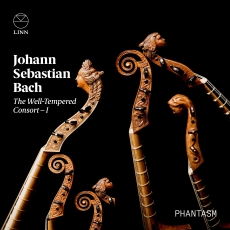Phantasm - J.S. Bach: The Well-Tempered Consort – I - YLE Klassinen
Bachin kontrapunktin värikkyys avautuu gamboilla
Musiikinystävien onneksi gambayhtyeet eivät tyydy soittelemaan vain renessanssin consort-helmiä, vaan etsivät ja sovittavat jatkuvasti uutta ohjelmistoa. Fretwork-yhtyeen loistelias Bach alio modo levy todisti vuosia sitten, että gambayhtye saa Bachin monimuotoisesta polyfoniasta irti sekä kirkkautta että sävyjä. Samaa polkua astelee Phantasm, joka on käynnistänyt levyLinn-yhtiölle sarjan The Well-Tempered Consort.
Ohjelmistossa ei siis ole Bachin suurta, absoluuttista kontrapunktia - Die Kunst der Fuge on soitettu gamboilla jo moneen kertaan. Sen sijaan Phantasm on valikoinut Bachin tuotannosta pienimuotoisempia helmiä, sellaisia joiden linjat ja äänialat sopivat gamboille sekä teknisesti että soinnillisesti. DWK:n ykkösvihon preludit ja fuugat muodostavat levyn ytimen, mutta mausteena on kolmeäänisiä inventioita, urkukoraaleita ja pari Musiikillisen uhrilahjan jylhempää ricercarea.
Bachin kontrapunktin tiheiköt avautuvat kirkkaina ja myös kotoisina, kun ne on ne purettu kolmesta kuuteen hengen gambayhtyeelle, jonka jäsenet pystyvät nostamaan olennaiset linjat esiin paremmin kuin hyväkään kosketinsoittaja. Phantasmin tasoinen yhtye osaa myös intonoida Bachin kromatiikkaa varsin lempeästi, mikä osaltaan lisää musiikin puhuttelevuutta, vaikka särmää välillä puuttuukin. Levyn parasta antia on kuitenkin se, kuinka värikkäänä ja moninaisena Bachin kontrapunkti näyttäytyy. Phantasmin valikoimina ja elävästi tulkitsemina fuugat, ricercaret ja inventiot kuulostavat hauskoilta karaktäärikappaleilta, eivät aikansa oppineimmalta kontrapunktilta.
Sen verran uskallan äänityksestä sanoa, että Fretworkin viidentoista vuoden takainen Bach alio modo oli kenties vieläkin siloisempi ja valonhohtoisempi. Mutta kyllä Phantasmin äänitystäkin mielikseen kuuntelee, etenkin kun soitto nasaaleja diskanttigamboja myöten on kevyen pakotonta. Mutta niin pitää ollakin, kun perkaa Bachin koko tuotannosta parhaiten sopivat päältä. Jään siis innolla odottamaan myös levylle luvattua jatko-osaa, kirkasväriselle Bach-tunnelmoinnille on aina tilausta.
Bach’s contrapuntal colours sparkle on viols
Luckily for music lovers, viol ensembles aren’t just playing renaissance consort gems, but are constantly seeking and arranging new repertoire. Fretwork’s glorious Bach Alio Modo album proved years ago that the viol consort can draw both transparency and colours from Bach’s diverse polyphony. The same path is followed by Phantasm, which has launched the series The Well-Tempered Consort for the record company Linn.
So the repertoire doesn’t contain Bach’s absolutely most learned counterpoint – the Art of Fugue has been played on viols many times already. Instead, Phantasm has selected smaller pearls from Bach’s production, ones whose lines and register suit the technique and sonority of the viols. The preludes and fugues from the Well-Tempered Clavier, Book 1, form the meat and bones of the album, but the spice is found in a three-part Invention, the organ chorales and the pair of great ricercares from the Musical Offering.
The thickets of Bach’s counterpoint are negotiated clearly and naturally when distributed among a viol consort of three to six players whose members can bring out the essential lines far better even than a good keyboardist. An ensemble on the level of Phantasm shapes Bach's chromaticism quite gently, which contributes to the eloquence of the music, even if an edge is sometimes missing. However, the best thing about the album is how colourful and diverse Bach’s counterpoint feels. As selected and vividly interpreted by Phantasm, fugues, ricercars, and inventions now sound like joyful character pieces, and not the most learned counterpoint of their time.
Dare I say that the sound engineering of the Fretwork recording of Bach Alio Modo from 15 years ago was perhaps even smoother and more luminous? But yes, I listen to Phantasm’s recorded sound with pleasure, especially when the playing of the ensemble is so light and unforced including even the nasal resonance of the treble viols. But this is how it should be when you seek out the most idiomatic pieces out of Bach’s entire oeuvre. So I’m eagerly awaiting the promised sequel to the album, since there’s always room for yet another visit into Bach’s brightly coloured and atmospheric spaces.

